![]()
Basic Data on Gender Equality in Japan
- Present Status of Japanese Women
-
Population
Japan has been seeing lower birthrates and an increase in the population of the aged. The total fertility rate (the total live birthrate for women in all age brackets for a certain year; in other words, the number of births per woman during her lifetime) has been declining since it fell below 2.00 in 1975. This is partly because the percentage of unmarried persons has been increasing in Japan.
The average age for a first marriage has been rising. As of 2002, Japanese men marrying for the first time are 29.1 years old on average; and the average age for Japanese women marrying for the first time stands at 27.4 years old. Women in their late 20s used to have the highest fertility rate in the past, but now approximately half of women in this age bracket still remain unmarried. The lifelong single rate (the percentage of people who are still single at age 50) has increased dramatically since 1960, particularly among men.
The aging rate (the proportion of the total population aged 65 years and over) has also been rising rapidly. Japan's population is aging mainly due to lower birthrates and longer life expectancies. The average life expectancy for women is 85.23 years as of 2002 and 78.32 years for men.
AGING RATE AND POPULATION OF ELDERLY PEOPLE AGED 65 AND OVER
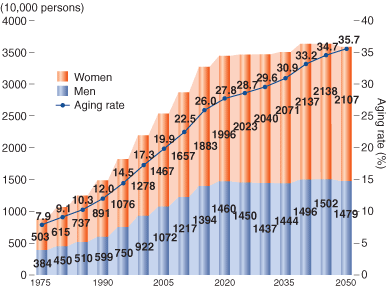
(Sources)
Population data leading up to the year 2000 are collected from the "National Census," Ministry of Public Management, Home Affairs, Posts and Telecommunications. Those for 2005 and onward represent the projected population as of October 1 of each year (median projection), which comes from "Population Projections for Japan: 2001-2050 (as of January 2002)," National Institute of Population and Social Security Research.TRENDS IN LIVE BIRTHS AND TOTAL FERTILITY RATE
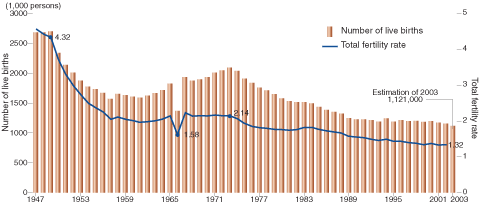
(Sources)
"Vital Statistics of Japan," Ministry of Health, Labour and Welfare -
Education
The percentage of students advancing to high school in Japan is extremely high, with the percentage of female students exceeding that of male students.
In terms of higher education level, most male students choose universities (undergraduate-level). On the other hand, some female students go to universities (undergraduate-level), while other female students enter junior colleges. Recently, more female students have been enrolling in four-year universities, while the percentage of female junior college students has been falling. Female students have recently come to major in more diversified areas.
-
Employment
The labor force participation rate of Japanese women shows an M-shaped curve with their participation declining due to marriage, childbirth and childcare. On the other hand, many women have a strong desire to work throughout their childbirth/childcare years. The latent labor force participation rate, which incorporates the labor force participation rate with the ratio of nonworking women willing to work, approximates an inverse U-shape curve.
In terms of how Japanese married couples spend their time, husbands spend little time on household duties, childcare and nursing care, regardless of whether their wives work or do not work. As a result, working wives have to shoulder their heavy responsibilities both at home and at work.
Recently, employment patterns have been particularly diversified. Part-time workers, temporary employees, contract workers and other non-regular workers account for a higher percentage both for men and women. This trend is particularly noticeable among female workers.
-
Agriculture, Forestry and Fisheries Industries
Japanese women accounted for 55.3% of the total labor force engaged in agriculture in 2003, 16.7% in forestry in 2002, and 16.6% in fisheries in 2002. Women engaged in agriculture, forestry and fisheries play important roles in their respective industries and contribute greatly to supporting livelihood and maintaining/revitalizing local communities. In terms of women's participation in local policy decision-making processes, women still account for a low percentage in agricultural committees responsible for coordinating farmland usage, but this percentage has been gradually increasing from 1.64% in 1999 to 1.82% in 2000 and 2.24% in 2001.
ENROLLMENT RATE FOR EACH SCHOOL CATEGORY
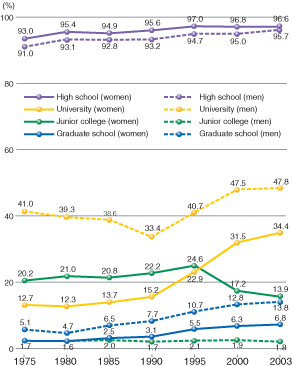
(Sources)
"School Basic Survey", Ministry of Education, Culture, Sports, Science and TechnologyWOMEN'S LATENT LABOR FORCE PARTICIPATION
RATE AVOIDS AN M-SHAPED CURVE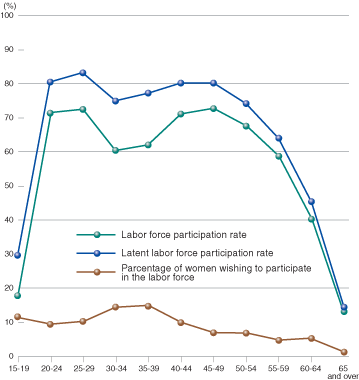
(Sources)
Latent labor force participation rate by age-bracket = Population of the labor force (by age-bracket) + Population of non-working population who want to work (by age-bracket) / Population aged 15 years and older (by age-bracket)Labour Force Survey"Detailed Tabulation"(2002),Ministry of Public Management, Home Affairs, Posts and Telecommunications
USAGE OF TIME BY MARRIED COUPLES
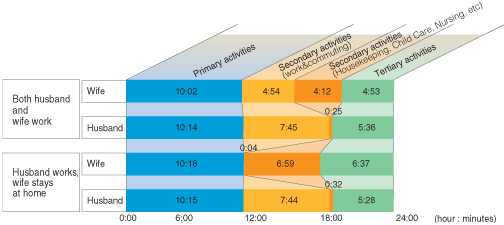
(Sources)
Primary activities refer to activities to daily life such as sleeping and eating. Secondary activities refer to activities of a highly obligatory nature undertaken as part of social lives and encompass work and housework. Tertiary activities refer to activities not included in the above that individuals participate in during their free time. "Nursing" and "Shopping" are included in "Housekeeping, childcare, etc." (Source) "Survey on Time Use and Leisure Activities" 2001, Minisry of Public Management, Home Affairs, Posts and Telecommunications
-
Population
